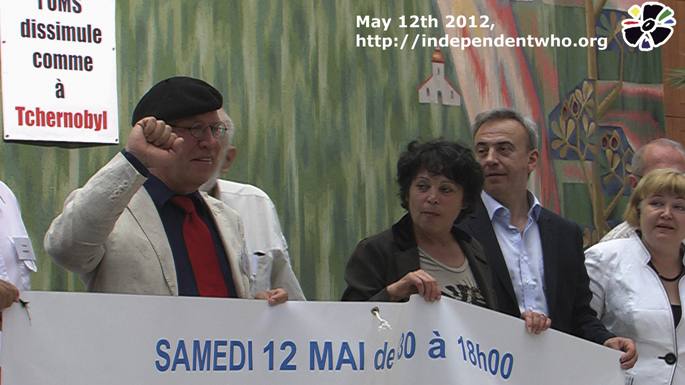
- For two days, doctors and scholars from Europe and Japan have reviewed their lessons learned from the Chernobyl nuclear disaster to Fukushima. Why it has reacted late, what is hidden and what needs to be known about the damage caused by radioactivity, how to help those condemned to survive in the contaminated regions.

I found the heroes. Not like the movies. Real, meat and bone. Men and women are fighting in their respective countries to make the truth known. Risking mocking, contempt, prison, risking their health, their life, without rest generously, some in the last 26 years, others for a year. Everyone wants to draw attention to it before it is too late. Its aim is to shed light on the health risks of atomic energy. Meeting in Geneva, 12 and 13 May 2012 ratified their decision to denounce barbarism and sexual abuse. Without worrying about the buzzing world, they were there, together, standing, alive. They've sent a message, we've been over 200 witnesses. Let's listen to them."
The words have been written by Pierre Fetet, who since April 2011 moved the Fukushima-over-blog site. The Scientific and Citizen Forum on Radioprotection, organized by Independent WHO, which was held in Geneva, Switzerland, has thus begun.
Independent WHO is an organization made up of volunteers of many classes that since 2007 has denounced every day the World Health Organization (WHO) unit of the World Health Organization (WHO). Independent WHO activists denounce that since then the WHO has not only investigated enough in radiation damage but has helped industry to cover and whitewash the consequences of nuclear accidents.
Throughout the working days of the past five years, activists have protested with banners in front of the WHO headquarters in Geneva. The days of May have brought together people from Chernobyl who are working along the lines that the WHO should really work to preserve the health of the people of the world and who have met them in the wake of the Fukushima disaster.
It was all flesh on a team of 200 people. They've been writers and journalists like Tchernobyl: déni passé, menace future? by Marc Molitor and Wladimir Tchertkoff Le Crime de Tchernobyl. There were some committed European scholars, such as the President of the CRIIRAD of France, Roland Desbordes, the former MEP Paul Lannoye, the doctor who analysed the influence of the chernobyl in Corsica, Michèle Rivasi, founder of CRIIRAD and today MEP, the most active doctor in nuclear chemistry, Michel Fámesis.
Since Fukushima, a wide selection of people dedicated to patient care and research in Japan has approached Geneva: Shinzo Kimura, Eisuke Matsu, Kolin Kobayashi, Aya Marumori, Wataru Iwata, President of the Fukushima Mothers Association, Miwa Chiwaki... But the Russian and Belarussian experts who have had the opportunity to see and fight on the ground the consequences of the Chernobyl accident have raised the greatest concern.
Because we have to live infected
Alexei Yablokov is a physician and member of the Russian Academy of Sciences, one of the most famous analyses of human health damage by Chernobyl – Consequences of the Catastrophe for People and the Environment, published together with Vassily Nesterenko and Alexei Nesterenko. Extensive work of 349 pages is available free of charge on the Internet. Belarusian Alexei Nesterenko, who was next to Yablov, also participated in the conference. To highlight the curiosity, the two were Soviet citizens when the Chernobyl power plant collapsed.
Along with Minsken Nesterenko, the capital of Belarus, Vladimir Babenko, director of the Belrad Institute, has delivered a conference entitled “Chernobyldik Fukushimara”. Have we learned anything in these twenty-five years?
“The main conclusion is disappointing,” says Babenko. “The Chernobyl disaster has taught the world nothing. Chernobyl and Fukushima: the same problems, the same mistakes. There was a time when Chernobyl was thought to have been so serious by the Soviet system. In Japan we have a very different system, an environment, a different culture and customs. But the mistakes are the same. The main mistake is to hide the true dimension of the nuclear accident, in an attempt to hide the truth.”
Impressed by the fact that 25 years later, in the face of a much more serious accident than Chernobyl, the inhabitants of Japan do not have enough information to protect themselves in their daily lives, Babenko has brought a gift: Japanese and French translation of the book “How to protect oneself and the child from radiation”.
The other two protagonists were the marriage formed by Yuri Bandazhevsky and Galina Bandazhevskaya, who refused to be the protagonists. After her husband went to jail, they were exiled to France, where they later settled in the Ukrainian capital of Kiev. The Ecology and Health Analysis and Coordination Center is located in the area.
The pediatrician and cardiologist Galina has explained what the health of the children of Belarus looks like today. Because, he said, “despite the fact that 26 years have passed, the problem is still very topical and little known: the state of health of people living in contaminated areas.”
Yuri Bandazhevsky holds the following title to his speech: “How to develop programmes and policies to protect the population from radiation from long-term isotope chronic penetration syndrome: an integrated model”.
In Bandazhevsky’s words, “although long-term isotope syndrome shows the influence of radioactive cesium throughout the human organism, official medicine does not take it into account in practice, which greatly limits the effectiveness of assistance to citizens living in contaminated areas.”
The program for people who must live infected on a daily basis requires control of people's radiations and food, prevention and assistance plans, balanced food to help bodies in imbalance, guarantee non-radiated food for the population... Program to help you survive healthier. 23 per cent of Belarus ' s territory is contaminated and more than 250,000 children live there.